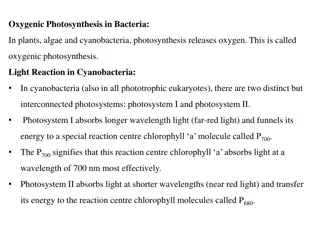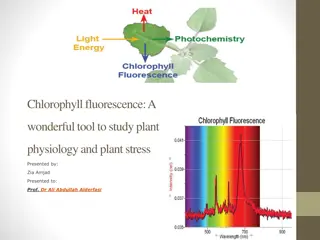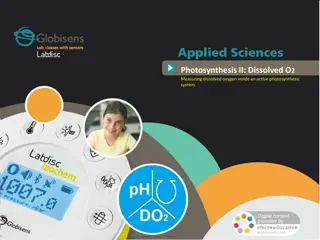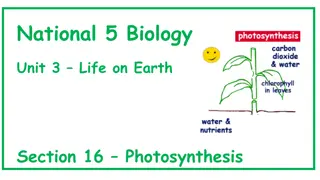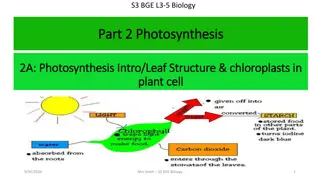Year 9 End of year revision
Learn how plants make their own food and the essential processes of photosynthesis. Discover why photosynthesis is crucial for maintaining oxygen and carbon dioxide levels. Explore leaf structure, chloroplast function, roles of carbon dioxide and water, and the significance of light energy. Uncover
0 views • 26 slides
Understanding the Role of Rubisco in Photosynthesis
Photosynthesis involves two stages, with Rubisco playing a crucial role in the light-independent stage by assisting in carbon dioxide fixation. It controls the initial reaction, converting CO2 into organic molecules essential for plant growth. Different adaptations in C3, C4, and CAM plants optimize
4 views • 15 slides
Understanding Photosynthesis and Limiting Factors
Photosynthesis is an endothermic reaction that takes in energy from its surroundings. The law of limiting factors explains how various factors such as light intensity, temperature, and CO2 concentration can impact the rate of photosynthesis. Additionally, the concept of the inverse square law helps
7 views • 45 slides
Understanding Bacterial Photosynthesis: Types and Processes
Photosynthesis is the conversion of light energy into chemical energy, crucial for growth and production of ATP. Prokaryotes such as cyanobacteria, purple and green bacteria, and halobacteria demonstrate different forms of photosynthesis. Oxygenic photosynthesis, found in cyanobacteria, releases oxy
2 views • 20 slides
Understanding Photosynthesis: Process, Importance, and Stages
Photosynthesis is a vital process where plants make their own food using carbon dioxide, water, and light energy. It plays a crucial role in producing oxygen, removing carbon dioxide from the air, and forming fossil fuels. The balanced equation for photosynthesis shows how glucose and oxygen are pro
0 views • 34 slides
Exploring Photosynthesis Through Air Pressure Measurement in Active Systems
This activity focuses on studying air pressure changes within a closed photosynthetic system to understand the process of photosynthesis. Students learn the key concepts behind photosynthesis, its importance for living organisms, and how plants produce energy through this metabolic process. By measu
1 views • 28 slides
Understanding Photosynthesis in Bacteria and Cyanobacteria
Oxygenic photosynthesis in plants, algae, and cyanobacteria releases oxygen. Cyanobacteria utilize photosystems I and II in their light reactions, with distinct roles in light absorption and electron transfer. Cyclic photophosphorylation involves only photosystem I, while non-cyclic photophosphoryla
0 views • 10 slides
Investigating the Effect of Light Intensity on Photosynthesis Using Pondweed
Explore the impact of light intensity on photosynthesis rates by conducting a practical experiment with aquatic plants like pondweed. Learn about the factors influencing photosynthesis and how to measure its rate effectively through counting oxygen bubbles produced. Follow a step-by-step guide to se
0 views • 12 slides
Understanding the Calvin Cycle in Photosynthesis
The Calvin cycle, also known as the light-independent reactions, is a crucial part of photosynthesis where carbon dioxide is converted into glucose. This cycle occurs in the stroma of chloroplasts and utilizes ATP and NADPH from the light-dependent reactions to produce sugars for plants. It consists
5 views • 15 slides
Understanding Photosynthesis and Its Processes
Photosynthesis is a crucial process where plants use sunlight to produce energy in the form of ATP and NADPH through light-dependent reactions, leading to the creation of sugars in the light-independent reactions. Factors such as temperature, light, and water play essential roles in regulating photo
0 views • 8 slides
Understanding Photosynthesis and Measuring Dissolved Oxygen
Explore the process of photosynthesis and the importance of dissolved oxygen within a photosynthetic system. Discover how environmental factors like light intensity influence the rate of photosynthesis, and learn how to measure dissolved oxygen using the SensorLab air pressure sensor. Engage in an e
0 views • 22 slides
Understanding Photosynthesis and Cycling of Matter in Living Systems
Photosynthesis, the process by which plants convert sunlight into chemical energy, and the cycling of matter through carbon, nitrogen, and water cycles are crucial aspects of living systems. Chloroplasts and chlorophyll play key roles in photosynthesis, while the carbon cycle highlights the essentia
0 views • 20 slides
Understanding Photosynthesis: Energy Transformations and Chlorophyll Absorption
In the process of photosynthesis, light energy is converted into chemical energy stored in sugar molecules through multiple energy transformations. Chlorophyll plays a key role in capturing light energy. By separating chlorophyll from leaf tissue and analyzing its absorbance at various wavelengths u
0 views • 13 slides
Understanding Chlorophyll Fluorescence in Plant Physiology
Chlorophyll fluorescence is a powerful tool developed in the 1990s for studying plant physiology and stress. It provides insights into photosynthetic processes at different levels, from subcellular to canopy. By measuring chlorophyll fluorescence, researchers can assess the efficiency of photosynthe
0 views • 16 slides
Understanding Photosynthesis: A Comprehensive Overview
Photosynthesis is the fundamental process through which plants produce food in the form of glucose. This intricate process involves the conversion of carbon dioxide and water into glucose using sunlight as the energy source. The key player in photosynthesis is chlorophyll, a green compound found in
0 views • 13 slides
Understanding Drought-Induced Reactive Oxygen Species Generation in Photosynthesis
Leaf responses to drought conditions leading to increased generation of reactive oxygen species (ROS) in photosynthesis are explained. Drought-induced stomatal closure affects CO2 uptake, promoting H2O2 production in peroxisomes and potential ROS production by the photosynthetic electron transport c
0 views • 5 slides
Understanding Potato Photosynthesis: Molecular Models and Chemical Changes
Explore the process of photosynthesis in potato plants through molecular models and chemical changes at different scales, from atomic-molecular to macroscopic. Learn how potato plants produce food through biosynthesis and cellular respiration, connecting the atomic-molecular scale to the macroscopic
0 views • 23 slides
The Potential for Oxygenic Photosynthesis on Planets Orbiting Red Dwarf Stars
Exploring the possibility of oxygenic photosynthesis and complex life on planets orbiting red dwarf stars, considering factors such as star life cycles, climate conditions, and radiation wavelengths. The evolution of complex life on Earth due to the essential role of oxygen and ozone is discussed in
0 views • 14 slides
Understanding Photosynthesis: Energy Conversion in Living Organisms
Explore the process of photosynthesis and how energy is harnessed by living organisms through the conversion of sunlight into high-energy sugars. Discover the essential role of ATP in cellular processes and learn about key scientists who contributed to our understanding of photosynthesis. Delve into
0 views • 22 slides
Understanding Photosynthesis: The Source of Life's Energy
In the world of biology, photosynthesis is a crucial process that enables plants to harness the energy of sunlight and convert water and carbon dioxide into essential high-energy carbohydrates. This process is essential for sustaining life on Earth, as all living organisms, including humans, rely on
0 views • 23 slides
Understanding Photosynthesis: The Process of Energy Conversion in Plants
Photosynthesis is a vital process where plants, algae, and cyanobacteria convert light energy from the sun into chemical energy in the form of glucose. This energy conversion involves the absorption of light by chlorophyll molecules in chloroplasts, leading to the generation of ATP and the formation
0 views • 12 slides
Understanding the Importance of Photosynthesis in the Carbon Cycle
Description of how photosynthesis allows plants to absorb CO2 and produce oxygen, human impacts on photosynthesis, positive human efforts like building greenhouses, fun facts, and different forms of carbon.
0 views • 7 slides
Understanding Photosynthesis in Higher Biology
Photosynthesis is the process by which plants convert light energy into carbohydrates. This revision guide covers the photosynthesis word equation, stages, uses of products, and the role of light and pigments. It explains the absorption of light by leaves and the importance of chlorophyll and access
0 views • 14 slides
Understanding Photosynthesis: Energy Conversion in Plants
Photosynthesis is a vital process where plants convert sunlight, carbon dioxide, and water into glucose and oxygen. This energy conversion is crucial for sustaining life on Earth, as it provides food for organisms and releases oxygen into the atmosphere. The process involves the utilization of chemi
0 views • 21 slides
Understanding Photosynthesis: The Process and Importance
Photosynthesis is a vital process where plants convert sunlight, water, and carbon dioxide into energy for growth. Plants, algae, and some bacteria carry out photosynthesis, utilizing chlorophyll to produce glucose, the primary source of energy for plants. The sun provides the energy essential for s
0 views • 21 slides
Understanding Leaf Structure and Photosynthesis in Biology
Green plants use photosynthesis to make their own food by converting light energy into starch and oxygen through chlorophyll in the chloroplasts of their cells. Learn about the structure of a leaf and how to test for starch in this informative presentation.
0 views • 6 slides
Understanding Photosynthesis: Process and Importance in Plants
Photosynthesis is a vital process in green plants where they use carbon dioxide and water to produce sugar and oxygen, facilitated by chloroplasts. Limiting factors such as light, water, and temperature can impact photosynthesis rate. Green plants are producers that make their own food through photo
0 views • 17 slides
Understanding Photosynthesis: A Vital Process in Biology
Photosynthesis is a fundamental process in biology where plants, algae, and certain bacteria harness sunlight to produce energy-rich compounds. This energy flows through food chains, ultimately sustaining all life forms on Earth. Explore the significance of photosynthesis in ecosystems and its role
0 views • 23 slides
Understanding Photosynthesis: Role of NADP and Division into Light and Dark Stages
In photosynthesis, NADP plays a crucial role in carrying hydrogen into the dark stage for carbon dioxide reduction. The process is divided into light and dark stages where different components like chlorophyll, chloroplasts, and electron transfer mechanisms are involved. This division ensures effici
0 views • 50 slides
Understanding Photosynthesis and Photophosphorylation Processes
Photosynthesis is a vital process where autotrophic organisms trap solar energy to convert it into chemical energy in the form of food. Non-cyclic photophosphorylation involves the transfer of phosphate groups and ATP synthesis utilizing light energy. This process takes place at photosystem II in ch
0 views • 10 slides
Factors Affecting Rate of Photosynthesis: Understanding Key Influences
Factors like light availability, carbon dioxide levels, water availability, and temperature play crucial roles in affecting the rate of photosynthesis. Enzyme function and the requirements of photosynthesis are also explored in relation to these factors in this educational content. Understanding the
0 views • 15 slides
Understanding Photosynthesis: The Importance and Mechanism
Photosynthesis is a vital process in plants, utilizing sunlight to produce energy for life on Earth. It occurs in chloroplasts, primarily in leaves, where chlorophyll captures light for the process. The green pigment in plants is due to chloroplasts containing photosynthetic pigments. This process i
0 views • 41 slides
Regulation of Photosynthesis in Arabidopsis Chloroplasts
Balancing photosynthesis with chloroplast metabolism is crucial for plant growth. Thioredoxins play a key role in regulating photosynthesis reactions in Arabidopsis chloroplasts. This study investigates the interplay between ferredoxin-dependent and NADPH-dependent thioredoxin systems in response to
0 views • 5 slides
Exploring Photosynthesis: Measuring Dissolved Oxygen in Photosynthetic Systems
Discover the significance of dissolved oxygen in photosynthesis and how environmental factors like light intensity influence the process. Engage in hands-on experiments to investigate the impact of varying light conditions on oxygen availability and photosynthetic rates.
0 views • 22 slides
Understanding Photosynthesis in Plants
Photosynthesis is a vital process where plants convert light energy into chemical energy to produce their food. This section covers the two-stage process of photosynthesis, including light reactions and carbon fixation, and explores the factors affecting plant growth. Learn about the importance of p
0 views • 42 slides
Understanding the Role of Glucose in Photosynthesis
Exploring how plants use glucose produced during photosynthesis, including its various uses such as providing energy, being stored as starch, and contributing to the formation of plant cell walls and other essential chemicals. The process of photosynthesis, the fate of glucose, and the conversion of
0 views • 11 slides
Exploring Photosynthesis: A Quantitative Analysis Vignette for Biology Students
Delve into the world of photosynthesis with an engaging vignette designed to enhance quantitative literacy skills in biology students. The focus is on understanding the relationship between carbon fixation, plant biomass, and forests as carbon sinks. Through interactive learning goals and objectives
0 views • 24 slides
Understanding the Calvin Cycle in Photosynthesis
The Calvin Cycle is a crucial part of photosynthesis where sugar is synthesized from smaller molecules using ATP and NADPH. It involves three phases: Carbon fixation, Reduction, and Regeneration of the CO2 acceptor. Steps include Carbon Fixation, Reduction, and Regeneration of RuBP. The cycle ultima
0 views • 9 slides
Understanding Photosynthesis: Importance, Process, and Pigments
Explore the crucial process of photosynthesis in plants, from the absorption of sunlight to the production of biomolecules. Discover the significance of leaf pigments, light absorption, and why leaves are green. Delve into the types of pigments and the reasons behind leaves changing colors. Uncover
0 views • 22 slides
Understanding Limiting Factors in Photosynthesis Using Liebig's Barrel Model
Students aged 14-16 are introduced to limiting factors in photosynthesis through an analogy model of Liebig's barrel. The model illustrates how the rate of photosynthesis is limited by the factor that is least abundant, similar to filling a barrel with water. By identifying analogous and non-analogo
0 views • 4 slides






